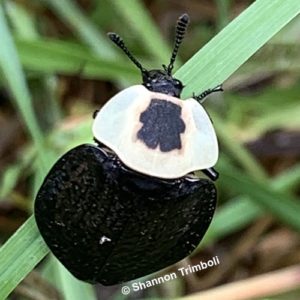
It’s been a while since I shared some of my nature-related discoveries with you. So, I thought it was about time to do it again, especially since I found and was able to observe so many fun and cool nature-related discoveries in August and September. Below are just a few of them.
American carrion beetles (Necrophila americana) are interesting beetles who lay their eggs on dead things. The adults and larvae will eat both carrion and any fly larvae that are present on the carcass. American carrion beetles are active from spring through fall, but are most active during the warmer months of summer.
To bee or not to bee? The first image is a common drone fly (Eristalis tenax). The second image is a honey bee. The common drone fly is an introduced flower fly / hover fly that mimics honey bees. Both insects were visiting my cup plant flowers. Notice the bigger eyes and shorter antennae of the drone fly compared to the honey bee. The drone fly was also sitting relatively still on the flower. Honey bees rarely stay still for long.
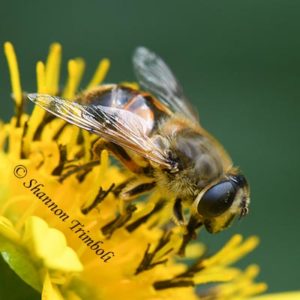
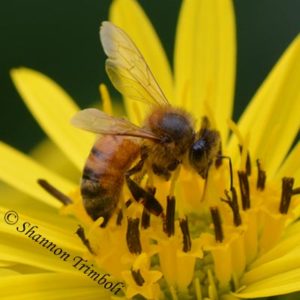
Sometimes it’s the little things that catch my eye, like these tiny, bright yellow, mushroom-looking things growing on a piece of wood on the forest floor. Despite their resemblance to a bunch of tiny mushrooms, they really aren’t mushrooms at all. They are the immature stage of a slime mold.
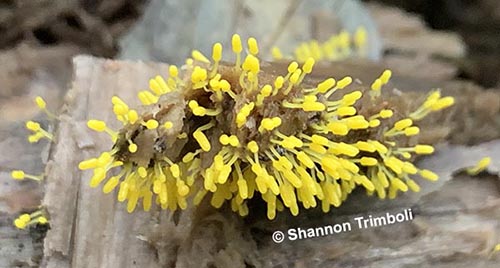
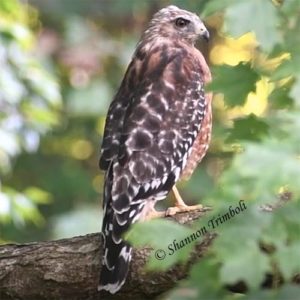
A red-shouldered hawk hunt visited our backyard to hunt several times over the last few weeks! It would often perch in one of our trees, wait until it saw something in the grass and then swoop down to catch it. Everything the hawk was catching was small and most of the time I couldn’t tell what it caught, but I know it caught at least one ring-necked snake. I posted a video of the hawk sitting in the tree on Facebook.
When we are enjoying our gardens, we often focus on the pollinators (like the bumble bee) or the flowers (like the great blue lobelia). But often there is much more going on. We just need to stop and look closely. Did you notice the spider legs peaking down from the right-hand flower and just above the “T” in my name? No wonder this bumble bee decided it was time to move on.
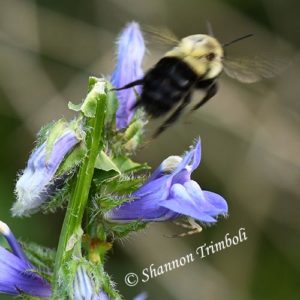
Around mid-August, as the fields light up with goldenrods and the yellow wingstem hits peak bloom, I always start finding lots of two-spotted blue-winged scoliid wasp (Scolia dubia dubia). Two-spotted blue-winged scoliid wasps can be found throughout the eastern U.S. They’re decent-sized wasps and can look intimidating, partly because the adults will congregate when feeding. That means where there is one, there are often several. However, they are relatively docile and are highly beneficial to have around because their larvae eat the beetle grubs that can damage grass roots and the roots of other plants.
I found the caterpillar of a hitched arches moth on a joe-pye weed growing in my nursery. Hitched arches are in the Noctuid family of moths. The moths are dark colored moths with white splotches. I think their wings look like they are covered in lichen. The caterpillars are generalist feeders, meaning that they eat a wide variety of plants. Even in the nursery, my plants are part of the ecosystem and doing their jobs.
So, what interesting nature-related discoveries have you made in your yard and community over the last few weeks? I always enjoy hearing what others are finding too.
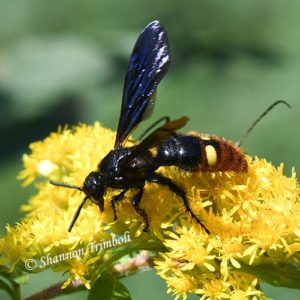
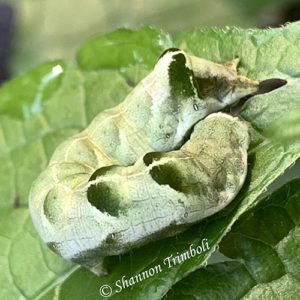

Backyard Ecology: Exploring Nature in Your Backyard
Nature isn’t just “out there.” It’s all around us, including right outside our doors. Hi, my name is Shannon Trimboli, and I am the host of Backyard Ecology. I live in southcentral Kentucky and am a wildlife biologist, educator, author, beekeeper, and owner of a nursery specializing in plants for pollinators and wildlife conservation. I invite you to join me as we ignite our curiosity and natural wonder, explore our yards and communities, and improve our local pollinator and wildlife habitat. Learn more or subscribe to my email list at www.backyardecology.net.

Leave a Reply